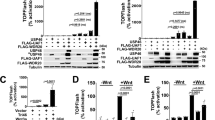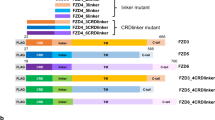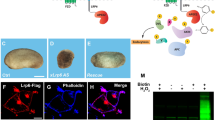Abstract
Secreted signaling proteins of the Wnt family are known to regulate a diverse range of developmental processes, and their signaling pathway through β-catenin is frequently activated in cancer. The identification of both Frizzled and LRP5/6 (LRP: low-density lipoprotein receptor-related protein) proteins as components of cell-surface receptors for Wnt proteins has raised questions about their individual functions. We have investigated this issue through a structure–function analysis of Frizzled and LRP proteins that have been implicated in Wnt1 signaling. Consistent with other reports, we find that LRP6/Arrow proteins deleted for their extracellular domain are able to activate the Wnt/β-catenin signaling pathway. Importantly, our results demonstrate that this signaling from LRP6/Arrow derivatives can occur in a Frizzled- and ligand-independent manner. Furthermore, we show that the PPSP motifs within the intracellular domain of LRP6 are required for signaling. In contrast to results with LRP6, overexpression of Frizzled proteins did not activate the pathway. Based on evidence of ligand binding to both Frizzled and LRP6, current models suggest that both proteins are components of a Wnt receptor complex that signals to β-catenin. In light of these models, our data imply that LRP5/6/Arrow proteins constitute the distal signal-initiating component of these receptors. The results also support the notion that LRP5/6 are candidate oncogenes.
This is a preview of subscription content, access via your institution
Access options
Subscribe to this journal
Receive 50 print issues and online access
$259.00 per year
only $5.18 per issue
Buy this article
- Purchase on Springer Link
- Instant access to full article PDF
Prices may be subject to local taxes which are calculated during checkout







Similar content being viewed by others
Abbreviations
- APC:
-
adenomatous polyposis coli
- Arr:
-
Arrow
- CRD:
-
cysteine-rich domain
- EGF:
-
epidermal growth factor
- Fzd/fz:
-
Frizzled
- GSK-3β:
-
glycogen synthase kinase-3β
- LDL:
-
low-density lipoprotein
- LDLR:
-
LDL receptor
- LRP:
-
LDLR- related protein
- S2:
-
Schneider 2
- TCF:
-
T-cell factor
References
Bafico A, Liu G, Yaniv A, Gazit A and Aaronson SA . (2001). Nat. Cell Biol., 3, 683–686.
Bhanot P, Brink M, Harryman Samos C, Hsieh J-C, Wang Y-S, Macke JP, Andrew D, Nathans J and Nusse R . (1996). Nature, 382, 225–230.
Bhanot P, Fish M, Jemison JA, Nusse R, Nathans J and Cadigan KM . (1999). Development, 126, 4175–4186.
Binari RC, Staveley BE, Johnson WA, Godavarti R, Sasisekharan R and Manoukian AS . (1997). Development, 124, 2623–2632.
Boutros M, Mihaly J, Bouwmeester T and Mlodzik M . (2000). Science, 288, 1825–1828.
Boyden LM, Mao J, Belsky J, Mitzner L, Farhi A, Mitnick MA, Wu D, Insogna K and Lifton RP . (2002). N. Engl. J. Med., 346, 1513–1521.
Bradley RS and Brown AMC . (1995). Mol. Cell. Biol., 15, 4616–4622.
Brown SD, Twells RCJ, Hey PJ, Cox RD, Levy ER, Soderman AR, Metzker ML, Caskey CT, Todd JA and Hess JF . (1998). Biochem. Biophys. Res. Commun., 248, 879–888.
Cadigan KM and Nusse R . (1997). Genes Dev., 11, 3286–3305.
Chan SDH, Karpf DB, Fowlkes ME, Hooks M, Bradley MS, Vuong V, Bambino T, Liu MYC, Arnaud CD, Strewler GJ and Nissenson RA . (1992). J. Biol. Chem., 267, 25202–25207.
Chelly J, Concordet JP, Kaplan JC and Kahn A . (1989). Proc. Natl. Acad. Sci. USA, 86, 2617–2621.
Chen CM and Struhl G . (1999). Development, 126, 5441–5452.
Deardorff MA, Tan C, Conrad LJ and Klein PS . (1998). Development, 125, 2687–2700.
Deardorff MA, Tan C, Saint-Jeannet JP and Klein PS . (2001). Development, 128, 3655–3663.
Eastman Q and Grosschedl R . (1999). Curr. Opin. Cell Biol., 11, 233–240.
Gazit A, Yaniv A, Bafico A, Pramila T, Igarashi M, Kitajewski J and Aaronson SA . (1999). Oncogene, 18, 5959–5966.
Giarre M, Semenov MV and Brown AMC . (1998). Ann. NY Acad. Sci., 857, 43–55.
He X, Saint Jeannet J-P, Wang Y, Nathans J, Dawid I and Varmus H . (1997). Science, 275, 1652–1654.
Hecht A and Kemler R . (2000). EMBO Rep., 1, 24–28.
Holmen SL, Salic A, Zylstra CR, Kirschner MW and Williams BO . (2002). J. Biol. Chem., 277, 34727–34735.
Howe LR, Crawford HC, Subbaramaiah K, Hassell JA, Dannenberg AJ and Brown AMC . (2001). J. Biol. Chem., 276, 20108–20115.
Hsieh JC, Rattner A, Smallwood PM and Nathans J . (1999). Proc. Nat. Acad. Sci. USA, 96, 3546–3551.
Huelsken J and Behrens J . (2002). J. Cell Sci., 115, 3977–3978.
Huelsken J and Birchmeier W . (2001). Curr. Opin. Genet. Dev., 11, 547–553.
Hussain MM, Strickland DK and Bakillah A . (1999). Annu. Rev. Nutr., 19, 141–172.
Kaplan JC, Kahn A and Chelly J . (1992). Hum. Mutat., 1, 357–360.
Karasawa T, Yokokura H, Kitajewski J and Lombroso PJ . (2002). J. Biolo. Chem, 277, 37479–37486.
Leyns L, Bouwmeester T, Kim SH, Piccolo S and DeRobertis EM . (1997). Cell, 88, 747–756.
Lin X and Perrimon N . (1999). Nature, 400, 281–284.
Little RD, Carulli JP, Del Mastro RG, Dupuis J and Osborne M . (2002). Am. J. Hum. Genet., 70, 11–19.
Liu G, Bafico A, Harris VK and Aaronson SA . (2003). Mol. Cell. Biol., 23, 5825–5835.
Longo KA, Kennell JA, Ochocinska MJ, Ross SE, Wright WS and MacDougald OA . (2002). J. Biol. Chem., 277, 38239–38244.
Mao B, Wu W, Davidson G, Marhold J, Li M, Mechler BM, Delius H, Hoppe D, Stannek P, Walter C, Glinka A and Niehrs C . (2002). Nature, 417, 664–667.
Mao B, Wu W, Li Y, Hoppe D, Stannek P, Glinka A and Niehrs C . (2001a). Nature, 411, 321–325.
Mao J, Wang J, Liu B, Pan W, Farr III GH, Flynn C, Yuan H, Takada S, Kimelman D, Li L and Wu D . (2001b). Mol. Cell, 7, 801–809.
Mumm JS and Kopan R . (2000). Dev. Biol., 228, 151–165.
Nusse R, Samos CH, Brink M, Willert K, Cadigan KM, Wodarz A, Fish M and Rulifson E . (1997). Cold Spring Harb. Symp. Quant. Biol., 62, 185–190.
Nusse R and Varmus HE . (1992). Cell, 69, 1073–1087.
Pinson KI, Brennan J, Monkley S, Avery BJ and Skarnes WC . (2000). Nature, 407, 535–538.
Polakis P . (2000). Genes Dev., 14, 1837–1851.
Sato A, Kojima T, Ui-Tei K, Miyata Y and Saigo K . (1999). Development, 126, 4421–4430.
Schlessinger J . (2000). Cell, 103, 211–225.
Schweizer L and Varmus H . (2003). BMC Cell Biol., 4, 4.
Semenov MV, Tamai K, Brott BK, Kuhl M, Sokol S and He X . (2001). Curr. Biol., 11, 951–961.
Shimizu H, Julius MA, Zheng Z, Giarre M, Brown AMC and Kitajewski J . (1997). Cell Growth Differ., 8, 1349–1358.
Tamai K, Semenov M, Kato Y, Spokony R, Liu C, Katsuyama Y, Hess F, Saint-Jeannet JP and He X . (2000). Nature, 407, 530–535.
Tamai K, Zeng X, Liu C, Zhang X, Harada Y, Chang Z and He X . (2004). Mol. Cell, 13, 149–156.
Tolwinski NS, Wehrli M, Rives A, Erdeniz N, DiNardo S and Wieschaus E . (2003). Dev. Cell, 4, 407–418.
Toyofuku T, Hong Z, Kuzuya T, Tada M and Hori M . (2000). J. Cell Biol., 150, 225–241.
Tsuda M, Kamimura K, Nakato H, Archer M, Staatz W, Fox B, Humphrey M, Olson S, Futch T, Kaluza V, Siegfried E, Stam L and Selleck SB . (1999). Nature, 400, 276–280.
Umbhauer M, Djiane A, Goisset C, Penzo-Mendez A, Riou J-F, Boucaut J-C and Shi D-L . (2000). EMBO J., 19, 4944–4954.
Uren A, Reichsman F, Anest V, Taylor WG, Muraiso K, Bottaro DP, Cumberledge S and Rubin JS . (2000). J. Biol. Chem., 275, 4374–4382.
Uusitalo M, Heikkila M and Vainio S . (1999). Exp. Cell Res., 253, 336–348.
van de Wetering M, Cavallo R, Dooijes D, van Beest M, van Es J, Loureiro J, Ypma A, Hursh D, Jones T, Bejsovec A, Peifer M, Mortin M and Clevers H . (1997). Cell, 88, 789–799.
Wang SW, Krinks M, Lin KM, Luyten FP and Moos M . (1997). Cell, 88, 757–766.
Wang YS, Macke JP, Abella BS, Andreasson K, Worley P, Gilbert DJ, Copeland NG, Jenkins NA and Nathans J . (1996). J. Biol. Chem., 271, 4468–4476.
Weeraratna AT, Jiang Y, Hostetter G, Rosenblatt K, Duray P, Bittner M and Trent JM . (2002). Cancer Cell, 1, 279–288.
Wehrli M, Dougan ST, Caldwell K, O'Keefe L, Schwartz S, Vaizel-Ohayon D, Schejter E, Tomlinson A and DiNardo S . (2000). Nature, 407, 527–530.
Yang-Snyder J, Miller JR, Brown JD, Lai CJ and Moon RT . (1996). Curr. Biol., 6, 1302–1306.
You Z, Saims D, Chen S, Zhang Z, Guttridge DC, Guan KL, MacDougald OA, Brown AMC, Evan G, Kitajewski J and Wang CY . (2002). J. Cell Biol., 157, 429–440.
Acknowledgements
We are grateful to Drs Fred Hess, Hans Clevers, Vincent Zecchini, Simon Kidd, Robert Nissenson, and Jeremy Nathans for supplying plasmids. We also thank C Dong, M Semenov, and M Goll for contributions to the early phases of analysing Frizzled constructs, and K Tolle for technical assistance. The mouse anti-Armadillo antibody N2 7A1 was produced in the laboratory of Dr Eric Wieschaus and was obtained from the Developmental Studies Hybridoma Bank (DSHB). The DSHB was developed under the auspices of the NICHD and is maintained by The University of Iowa, Department of Biological Sciences, Iowa City, IA 52242, USA.
This work was supported by US Army Medical Research and Materiel Command fellowships DAMD17-99-1-9388 (to KB) and DAMD17-02-1-0359 (to LACS), by NIH MSTP Grant GM67739, by a fellowship from the Ministerio de Educacion, Cultura y Deportes of Spain (to JMGS), and by NIH Grant CA47207 (to AMCB).
Author information
Authors and Affiliations
Corresponding author
Rights and permissions
About this article
Cite this article
Brennan, K., Gonzalez-Sancho, J., Castelo-Soccio, L. et al. Truncated mutants of the putative Wnt receptor LRP6/Arrow can stabilize β-catenin independently of Frizzled proteins. Oncogene 23, 4873–4884 (2004). https://doi.org/10.1038/sj.onc.1207642
Received:
Revised:
Accepted:
Published:
Issue Date:
DOI: https://doi.org/10.1038/sj.onc.1207642
Keywords
This article is cited by
-
Ninjurin1 drives lung tumor formation and progression by potentiating Wnt/β-Catenin signaling through Frizzled2-LRP6 assembly
Journal of Experimental & Clinical Cancer Research (2022)
-
Transmembrane protein 97 exhibits oncogenic properties via enhancing LRP6-mediated Wnt signaling in breast cancer
Cell Death & Disease (2021)
-
Wnt/β-catenin signaling in cancers and targeted therapies
Signal Transduction and Targeted Therapy (2021)
-
Cell competition corrects noisy Wnt morphogen gradients to achieve robust patterning in the zebrafish embryo
Nature Communications (2019)
-
Usp16 modulates Wnt signaling in primary tissues through Cdkn2a regulation
Scientific Reports (2018)



